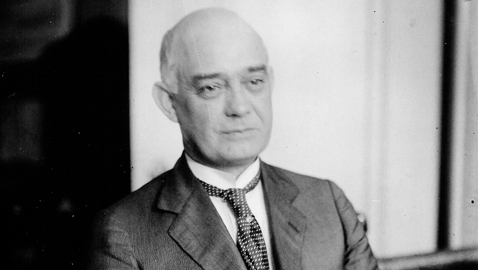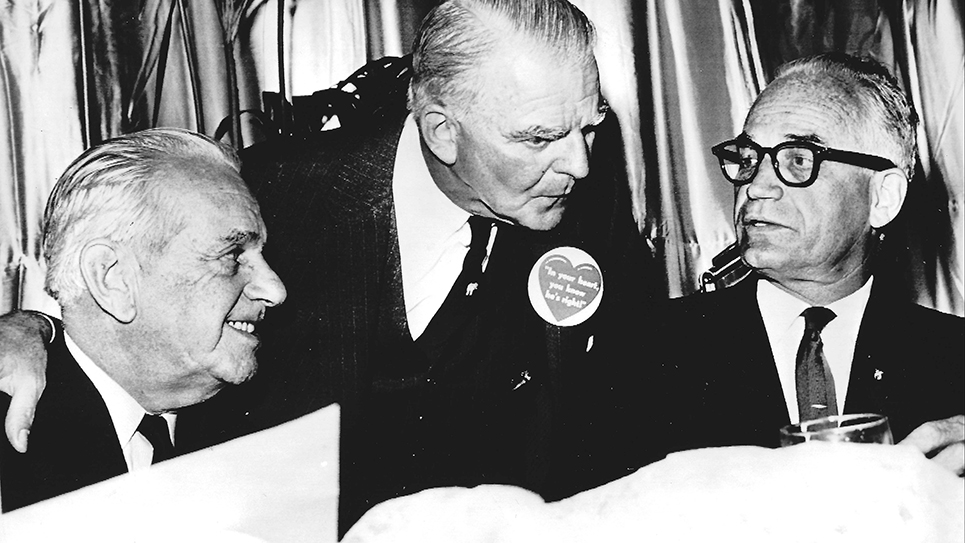Austin Peay was once one of Tennessee’s more famous governors, hailed as perhaps one of the most talented reformers in the state’s history. The late governor’s legacy is hardly confined to the university named for him in his home city of Clarksville.
Born on June 1, 1876 in Kentucky, Austin Peay was named for his father, who was a farmer. Peay managed to get an education and married Sallie Hurst when he was only nineteen years old and impoverished. Peay had moved to Clarksville, Tennessee to commence the practice of law and by 1900 he was a candidate for the Tennessee House of Representatives. Peay won the election and was only twenty-four years old. Peay was popular enough with his home folks to win a second term in 1902, but did not seek reelection in 1904. Instead, he accepted the chairmanship of the Tennessee Democratic Committee.
Austin Peay was Governor Malcolm Patterson’s campaign manager in 1908, but an incident left him disillusioned with politics. Peay was close to Colonel Duncan B. Cooper who had sought out Peay on a fateful day following the bitter 1908 contest for the Democratic gubernatorial nomination. Governor Patterson had been challenged by former U. S. senator Edward Ward Carmack in the Democratic primary. The former senator campaigned as the champion of prohibition, while Patterson was both personally and politically “wet”. Carmack won majorities in most of rural Tennessee, while Patterson carried the more urban areas. It was a ferocious and close contest and when Carmack lost, he became the editor of the Nashville Tennessean, which was owned by Colonel Luke Lea. Carmack had been a newspaperman prior to his election to Congress and the United States Senate and he excelled in paring away one’s flesh in print. Colonel Duncan B. Cooper, although both a friend and employer of Carmack’s in the past, was close to Malcolm Patterson and as such, was flayed in in the pages of the Tennessean. Cooper and his son Robin had searched for Peay, but unable to find him, went about their business and soon encountered E. W. Carmack on a Nashville street. All the men were armed and apparently Carmack was the first to open fire, wounding Robin Cooper, but the younger Cooper proved to be a much better shot than the former senator and Carmack was left dead in the gutter.
Even though Austin Peay was neither present nor participated in the murder of Senator Carmack, the incident left him uneasy and disgusted. He withdrew from politics and concentrated on his law practice and the running of a farm he owned. Peay’s disenchantment with politics lasted the better part of a decade. It was a wise decision, as Tennessee Democrats were consumed by infighting, intense factionalization and bitterness. He announced he would run for governor in 1918 and sought the Democratic nomination, but lost to Judge Albert H. Roberts, who won the general election. Roberts’ term as governor proved to be a difficult time and he managed to upset just about every special interest group in the state.
1920 was the first election in which women in Tennessee could participate and they helped to administer a thorough defeat for Democrats. Governor A. H. Roberts lost to seventy-two year old Alf A. Taylor, a veteran politician and Republican. Congressmen John Moon, Cordell Hull, and Thetus Sims were swept out of office, either in the primary or general elections and Republicans won each seat. Austin Peay concluded he would run again for governor in 1922 and faced serious opposition in the Democratic primary from one of Tennessee’s most famous Democrats: former governor Benton McMillin. McMillin had served in Congress for twenty years before being elected governor in 1898. After having served two terms as governor, McMillin sought repeatedly to win a seat in the United States Senate, but never quite made it. McMillin had again been nominated to run for governor in 1912 by Tennessee Democrats, but he lost narrowly to incumbent Republican Ben W. Hooper. In 1913, McMillin was appointed Minister to Peru, by the newly elected president, Woodrow Wilson. McMillin spent almost the entirety of the Wilson administration in Lima, Peru.
Benton McMillin was seventy-seven years old in 1922 and despite his age, the “Old Warhorse” of Tennessee politics waged an active and energetic campaign. The contest for the Democratic nomination was quite close and Austin Peay won by just over four thousand votes. His majority came from his margin in Shelby County, which was more than seven thousand votes. Peay had the support of E. H. Crump, leader of the Shelby County political machine and it was a decision the Memphis Boss would come to regret.
Austin Peay went on to win the general election over Governor Alf A. Taylor and Peay entered the governor’s office having defeated two of Tennessee’s political institutions. Yet Peay faced significant challenges as governor; Tennessee was in debt, the state’s educational system was largely in shambles, and there were few good roads. The state’s government had also become something of a bureaucratic nightmare with at least sixty-four different departments and agencies, some of which operated outside the governor’s control. Governor Peay moved immediately to reorganize state government. The Administrative Reorganization Act reduced the departments and agencies into exactly eight departments; each department would be run by a Commissioner, who in turn reported directly to the governor. The reorganization also allowed the governor to better control the state budget.
Tennessee’s budget was largely funded through property taxes and Peay set out to reform tax collection, managing to reduce property taxes for many Tennesseans, while instituting a new tax on corporations. Peay also adopted a “pay-as-you-go” approach to state projects rather than issuing bonds.
Seeking a second term in 1924, Peay again won the backing of E. H. Crump, leader of the Shelby County political organization with the new University of Tennessee medical school, which was located in Memphis. Still, it was an uneasy alliance as Peay was quite close to former U. S. senator Luke Lea, who was a power in the governor’s administration and a Crump rival. Lea owned daily newspapers in Knoxville, Nashville and Memphis and wielded enormous influence. The Memphis Boss loathed Lea and the Colonel returned Crump’s dislike in ample measure.
Governor Peay remained popular and beat the Republican nominee by about the same majority as he had won two years earlier.
During his second administration, Governor Peay decided to address education in Tennessee. The Education Act of 1925 lengthened the school calendar to eight months out of the year and that expansion was paid for by a new tobacco tax. The Act also established a salary schedule for teachers, as well as new requirements for holding a teaching license. Peay managed to increase funding for the University of Tennessee. The genesis for Austin Peay University and the University of Tennessee Martin campus occurred during the second administration of Governor Peay. Peay’s reforms also brought Tennessee into the modern age and the little one-room schoolhouses dotted across the state soon began to disappear, while larger, more centralized schools took their place.
Governor Peay did expand state government, creating the State Parks and Forestry Commission and convinced the legislature to appropriate money for the purchase of land in East Tennessee, which became the Great Smoky Mountains National Park. That would substantially increase Governor Peay’s popularity in East Tennessee, which was already high.
Austin Peay signed into law the notorious Butler Bill, which banned the teaching of evolution in Tennessee schools. That law became the basis for the Scopes Trial.
Governor Peay decided to run for a third two-year term in 1926 and encountered stiff opposition inside his own party. Many urban Democrats resented the governor program, which heavily taxed the urban areas to pay for improvements in more rural communities. E. H. Crump was dismayed by what he considered Shelby County receiving little for the taxes citizens paid. Nashville Mayor Hilary Howse, who headed the Davidson County political machine was equally upset and determined to dislodge Peay from the governor’s chair. Tennessee’s senior United States senator, Kenneth D. McKellar, was growing suspicious Peay intended to get himself reelected in 1926 and then run for the Senate in 1928. The same thought had occurred to Crump, although the governor denied any interest in running for the U. S. Senate.
One prominent former Peay supporter was eccentric millionaire grocer Clarence Saunders, founder and owner of the Piggly-Wiggly stores. Saunders had fallen out with the governor and was struggling financially. Saunders joined Crump, Howse and McKellar in supporting State Treasurer Hill McAlister in the Democratic primary.
A typical campaign appearance by Governor Peay was that in Blountville on July 11, 1926. Peay used that occasion to chastise many of the state’s newspapers that were supporting his opponent in the primary. The governor declared newspapers could be an effective instrument for progress in Tennessee, but lamented, “they won’t tell the truth in some instances.”
Peay dismissed opposition based on his seeking a third two-year term, saying, “No precedent was ever established in Tennessee regulating the tenure of the office of the governor. The founders of the constitution left the question of tenure of office up to the people of the state.”
Governor Peay came to the heart of the matter, telling his audience the opposition to his reelection was merely a cabal of disappointed and dissatisfied politicians who wanted power for themselves.
The governor was careful to point out before his administration, Tennessee had been millions of dollars in debt and under his management, the state enjoyed a surplus.
McAlister pressed Peay hard, but lost narrowly. McAlister had run quite well in Tennessee’s urban centers, but Governor Peay was saved by his enduring popularity in East Tennessee. Tennessee’s rural communities remained grateful to the governor and thousands of Democrats came out to support him for a third term.
Peay had bragged the Memphis Boss could not defeat him for re-nomination in the Democratic primary and Crump was shocked by the governor’s success. Austin Peay was the first Tennessee governor to be reelected to a third consecutive term since the Civil War.
Yet his third administration would be the least successful of his tenure as governor. Peay was beginning to suffer from heart trouble, which plagued him throughout the last year of his life. Peay’s relations with the Tennessee General Assembly had deteriorated along with his health. The governor had difficulty in getting the legislature to go along with his proposals and the session further depleted Peay’s strength.
Peay was quite ill for much of his last year in office. In February of 1927, the governor was ailing from a severe case of pneumonia, an oftentimes fatal illness at the time. The governor’s son, Austin, Jr., a student at the University of Tennessee, hurried home to be at his father’s side. The governor’s daughter also came to Nashville to be with her father. Governor Peay had gone to Washington to meet with Secretary of the Interior Hubert Work. While in Washington, Peay caught a cold which developed into pneumonia.
Out of respect for the governor and concern for his condition, the legislature adjourned. Dr. W. R. Fessey released a statement to the press that the governor was “desperately ill”, although he tried to reassure folks by saying Peay was “holding his own”.
As his fever burned, Peay asked for ice cream repeatedly. The governor was so ill, he became delirious. If the pneumonia was not bad enough, by the middle of February, it was believed the governor had suffered two heart attacks on the same day.
Finally, the governor’s physicians detected some improvement in their patient. Austin Peay, Jr. returned to medical school in Memphis, along with his sister, Mrs. P. L. Armstrong. The governor’s wife, quite naturally deeply upset by her husband’s illness, had sat by his bedside for days without sleep. Mrs. Peay was able to rest and the doctor said she would take charge of Peay’s care, becoming “governor of the governor”. Mrs. Peay announced she would likely take her stricken husband to Florida for rest and was insistent he not overwork, as was his habit. Mrs. Peay said he would maintain regular office hours, but would not be bringing work home during the evenings.
When the legislature passed a bill that would have given them a special bonus, Peay vetoed it. The angry legislators promptly overrode the governor’s veto, but they did not reckon with the determination of Austin Peay. The governor sued the Tennessee General Assembly in his capacity as a private citizen and won.
It was his last victory as governor. Only fifty-one years old, Austin Peay died suddenly on October 2, 1927 from a cerebral hemorrhage.







